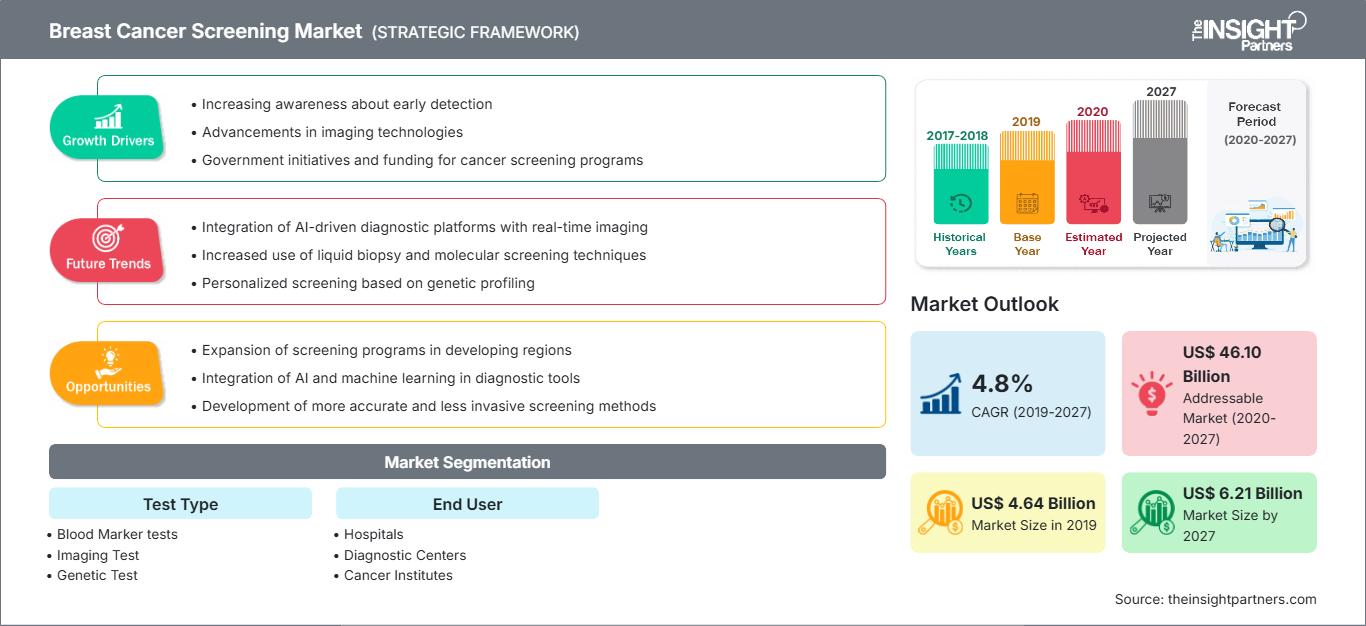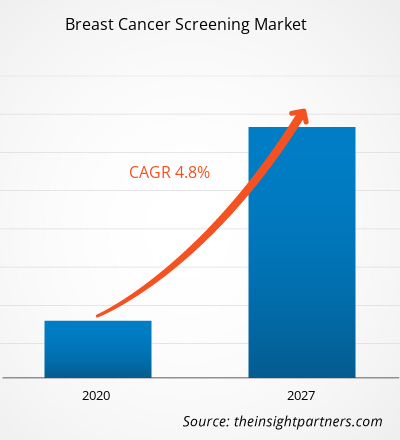[Rapport de recherche] Le marché du dépistage du cancer du sein devrait atteindre 6 209,25 millions de dollars américains d'ici 2027, contre 4 638,63 millions de dollars américains en 2019 ; sa croissance devrait atteindre un TCAC de 4,8 % entre 2020 et 2027.
Le cancer du sein est le cancer le plus fréquent et le plus répandu chez les femmes ; il se développe dans les tissus mammaires, généralement dans les canaux (tubes qui transportent le lait jusqu'au mamelon) et les lobules (glandes qui produisent le lait). Il peut également survenir dans le tissu adipeux ou le tissu conjonctif fibreux des seins. Un diagnostic précoce du cancer du sein est important, car il peut empêcher la maladie de devenir critique et garantir le succès d'un traitement curable. Les méthodes de dépistage pour le diagnostic du cancer du sein comprennent la mammographie, l'imagerie par résonance magnétique (IRM), l'échographie, etc. L'objectif principal du dépistage est de détecter la maladie à son stade le plus précoce et le plus traitable. Les procédures de dépistage permettent d’identifier les premiers signes du cancer, avant même que les symptômes ne commencent à apparaître.
Personnalisez ce rapport en fonction de vos besoins
Vous bénéficierez d’une personnalisation sur n’importe quel rapport - gratuitement - y compris des parties de ce rapport, ou une analyse au niveau du pays, un pack de données Excel, ainsi que de profiter d’offres exceptionnelles et de réductions pour les start-ups et les universités
Marché du dépistage du cancer du sein: Perspectives stratégiques

- Obtenez les principales tendances clés du marché de ce rapport.Cet échantillon GRATUIT comprendra une analyse de données, allant des tendances du marché aux estimations et prévisions.
Vous bénéficierez d’une personnalisation sur n’importe quel rapport - gratuitement - y compris des parties de ce rapport, ou une analyse au niveau du pays, un pack de données Excel, ainsi que de profiter d’offres exceptionnelles et de réductions pour les start-ups et les universités
Marché du dépistage du cancer du sein: Perspectives stratégiques

- Obtenez les principales tendances clés du marché de ce rapport.Cet échantillon GRATUIT comprendra une analyse de données, allant des tendances du marché aux estimations et prévisions.
Aperçu du marché
Prévalence croissante du cancer du sein à l'échelle mondiale
Le cancer du sein est l'une des principales causes de décès dans le monde et affecte profondément la qualité de vie. Il constitue donc un fardeau pour la société s'il n'est pas diagnostiqué et traité à temps. Selon les estimations de l'American Cancer Society, le cancer du sein est le type de cancer le plus courant aux États-Unis, ayant causé une morbidité chez environ 234 087 personnes et entraîné 41 904 décès en 2018. De plus, environ 276 480 nouveaux cas sont attendus dans le pays en 2020. Selon le rapport Globocan 2019, en Allemagne, le nombre total de cas de cancer du sein en 2018 était de 71 888, et la maladie a entraîné environ 19 376 décès cette année-là. De plus, selon le rapport Globocan, en 2018, on a recensé environ 367 900 nouveaux cas de cancer du sein et 97 972 décès en Chine. En Inde, les ONG, les agences gouvernementales et les organisations caritatives mettent l'accent sur la sensibilisation de la population au cancer du sein afin de promouvoir un dépistage précoce, de proposer un module de traitement complet et d'apporter un soutien à la prise en charge du cancer du sein. Ces initiatives sont le résultat de la prévalence croissante de ce type de cancer dans le pays. Selon les estimations du rapport Globocan, en 2018, l'Inde a signalé environ 162 468 nouveaux cas de cancer du sein et 87 090 décès. Cette prévalence croissante du cancer du sein dans différentes régions du monde accroît la demande mondiale de dispositifs de dépistage.
Analyse du marché par type de test
Le marché du dépistage du cancer du sein, par type de produit, est segmenté en tests de marqueurs sanguins, tests d'imagerie, tests génétiques et tests d'immunohistochimie. Le segment des tests d'imagerie détenait la plus grande part de marché en 2019 et devrait également enregistrer le TCAC le plus élevé du marché au cours de la période de prévision.
Informations basées sur l'utilisateur final
Sur la base de l'utilisateur final, le marché du dépistage du cancer du sein a été segmenté en hôpitaux, centres de diagnostic, instituts de cancérologie et laboratoires de recherche. Le segment des hôpitaux détenait la plus grande part de marché en 2019, tandis que le segment des centres de diagnostic devrait enregistrer le TCAC le plus élevé du marché au cours de la période de prévision.
Le lancement et l'approbation de produits sont une stratégie couramment adoptée par les entreprises du marché du dépistage du cancer du sein pour étendre leur présence mondiale et répondre à la demande croissante en élargissant leur portefeuille de produits. Elles adoptent également cette stratégie pour élargir leur clientèle à l'échelle mondiale, ce qui leur permet également de maintenir leur marque à l'échelle mondiale. Par exemple, en juin 2017, Siemens Healthineers a reçu l'approbation de la Food and Drug Administration (FDA) pour le produit syngo.via VB20 qui est susceptible d'être utilisé pour l'imagerie moléculaire (IM) de Siemens Healthineers - une nouvelle version du logiciel de visualisation intelligente établi par la société pour l'imagerie multimodale.
Marché du dépistage du cancer du sein
Les tendances et facteurs régionaux influençant le marché du dépistage du cancer du sein tout au long de la période de prévision ont été analysés en détail par les analystes de The Insight Partners. Cette section aborde également les segments et la géographie du marché du dépistage du cancer du sein en Amérique du Nord, en Europe, en Asie-Pacifique, au Moyen-Orient et en Afrique, ainsi qu'en Amérique du Sud et en Amérique centrale.
Portée du rapport sur le marché du dépistage du cancer du sein| Attribut de rapport | Détails |
|---|---|
| Taille du marché en 2019 | US$ 4.64 Billion |
| Taille du marché par 2027 | US$ 6.21 Billion |
| TCAC mondial (2019 - 2027) | 4.8% |
| Données historiques | 2017-2018 |
| Période de prévision | 2020-2027 |
| Segments couverts |
By Type de test
|
| Régions et pays couverts | Amérique du Nord
|
| Leaders du marché et profils d'entreprises clés |
|
Densité des acteurs du marché du dépistage du cancer du sein : comprendre son impact sur la dynamique des entreprises
Le marché du dépistage du cancer du sein connaît une croissance rapide, portée par une demande croissante des utilisateurs finaux, due à des facteurs tels que l'évolution des préférences des consommateurs, les avancées technologiques et une meilleure connaissance des avantages du produit. Face à cette demande croissante, les entreprises élargissent leur offre, innovent pour répondre aux besoins des consommateurs et capitalisent sur les nouvelles tendances, ce qui alimente la croissance du marché.
- Obtenez le Marché du dépistage du cancer du sein Aperçu des principaux acteurs clés
Marché du dépistage du cancer du sein - Par type de produit
- Test de marqueur sanguin
- Test d'imagerie
- Test génétique
- Test d'immunohistochimie
Marché du dépistage du cancer du sein - Par application
- Centres de diagnostic
- Hôpitaux
- Laboratoires de recherche
- Instituts de cancérologie
Dépistage ...Dépistage du cancer du sein - Par application
- Centres de diagnostic
- Hôpitaux
- Laboratoires de recherche
- Instituts de cancérologie
Dépistage du cancer du sein - Par type de produit
- Test de marqueur sanguin
- Test d'imagerie
- Test génétique
- Test d'immunohistochimie
Dépistage du cancer du sein - Par application
- Centres de diagnostic
- Hôpitaux
- Laboratoires de recherche Par géographie
- Amérique du Nord
- États-Unis
- Canada
- Mexique
- Europe
- France
- Allemagne
- Italie
- Royaume-Uni
- Espagne
- Reste de l'Europe
- Asie Pacifique
- Chine
- Inde
- Corée du Sud
- Japon
- Australie
- Reste de l'Asie-Pacifique
- Moyen-Orient et Afrique
- Afrique du Sud
- Arabie Saoudite
- EAU
- Reste du Moyen-Orient et Afrique
- Sud Amérique
- Brésil
- Argentine
- Reste du Sud Amérique
Profils d'entreprises
- General Electric Company
- Siemens Healthineers AG
- Exact Sciences Corporation
- Koninklijke Philips NV
- Hologic, Inc.
- BD
- Myriad Genetics, Inc.
- Oncocyte Corporation
- Danaher
- POC Medical Systems
- Analyse historique (2 ans), année de base, prévision (7 ans) avec TCAC
- Analyse PEST et SWOT
- Taille du marché Valeur / Volume - Mondial, Régional, Pays
- Industrie et paysage concurrentiel
- Ensemble de données Excel
Rapports récents
Rapports connexes
Marché du cancer des os Marché du cancer anal Marché des technologies de dépistage du cancer Marché des thérapies contre le cancer des voies biliaires Marché des antigènes cancéreux Marché des thérapies antihormonales contre le cancer Marché du traitement du cancer de l'appendice Marché de la douleur cancéreuse Marché de l'immunothérapie contre le cancer Marché de la cachexie cancéreuse Marché des anticorps monoclonaux contre le cancer Marché du cancer des voies biliaires Marché du diagnostic du cancer du sein Marché des biomarqueurs du cancer Marché du diagnostic du cancer Marché des inhibiteurs de mTOR contre le cancer Marché des thérapies contre le cancer du sein Marché du diagnostic du cancer du cerveau Marché du dépistage du cancer du seinTémoignages
Raison d'acheter
- Prise de décision éclairée
- Compréhension de la dynamique du marché
- Analyse concurrentielle
- Connaissances clients
- Prévisions de marché
- Atténuation des risques
- Planification stratégique
- Justification des investissements
- Identification des marchés émergents
- Amélioration des stratégies marketing
- Amélioration de l'efficacité opérationnelle
- Alignement sur les tendances réglementaires
- Amérique du Nord




















 Obtenez un échantillon gratuit pour - Marché du dépistage du cancer du sein
Obtenez un échantillon gratuit pour - Marché du dépistage du cancer du sein